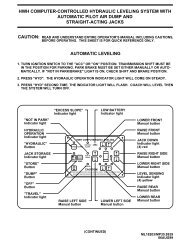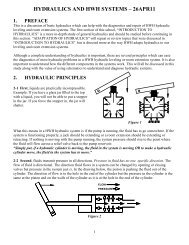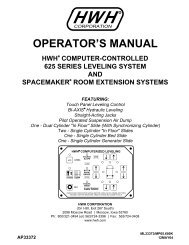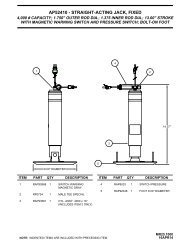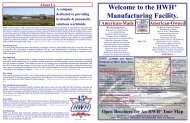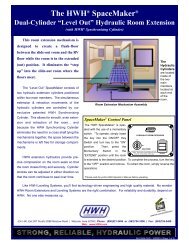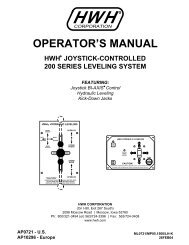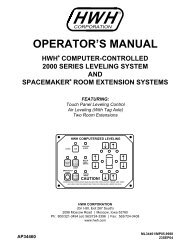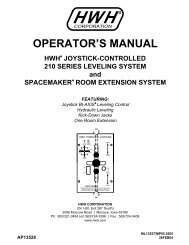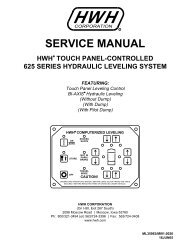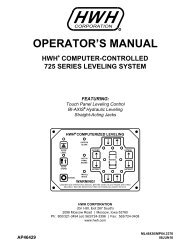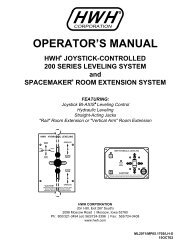AIR SUSPENSIONS AND HWH - HWH Corporation
AIR SUSPENSIONS AND HWH - HWH Corporation
AIR SUSPENSIONS AND HWH - HWH Corporation
- No tags were found...
You also want an ePaper? Increase the reach of your titles
YUMPU automatically turns print PDFs into web optimized ePapers that Google loves.
To check this, simply turn the leveling system controls on and push the manual “DUMP” button. If airstarts to exhaust from the air dump valves, and the vehicle lowers, the protection valve is leaking. Theproblem is that because the protection valve is not a zero leak valve, there is no real repair for this unlessthe leak exceeds the allowable DOT tests. Even putting a new protection valve in the system will notguarantee a solution for the problem. Pumping the brake pedal to lower the air pressure in the vehicle airsupply to approximately 30 psi is the only real solution. As long as there is not enough air pressure toactually raise the vehicle, a leaky protection valve will not affect the system.Returning a vehicle to ride height is very simple; start the engine and build up some air pressure. The airdump valves should be closed unless the system is in an automatic leveling mode or the control panel is onand the dump button is being pushed. As the vehicle lowers when the jacks are retracted, the height controlvalves will be in the raise position. Air will be directed to the air bags until the vehicle is at the correct rideheight.WARNING: DO NOT CRAWL UNDER A VEHICLE UNLESS THE FRAME OF THE VEHICLEIS PROPERLY SUPPORTED. DO NOT USE THE <strong>AIR</strong> SUSPENSION OR LEVELING JACKSTO SUPPORT THE VEHICLE WHILE UNDER THE VEHICLE.2-2.3 <strong>HWH</strong> air dump valve diagnostics. The diagnostics for the air dump valves is also very simple.If the valves will not dump air, first determine if one or all valves will not dump air. If no valves willdump air, the control box or panel would probably be the best place to start. If any one valve is working,that indicates the control box or panel is working. (The 4 lever 100/110 systems have two separate outputsfor the front and rear valves. Although unlikely, if front or rear valves are working and the others are not,it could be the control panel.) In either case, starting at the dump valves should always get you to theproblem. First, check the exhaust ports of the valves for blockage; these ports can become clogged withdirt or small bug homes. If the ports are not plugged, check for voltage between the two wires for thevalve. You need at least 9 volts (with the valve plugged in and turned on) to open a dump valve. If goodvoltage is present, the dump valve is bad. If voltage is not present, work your way back to the control boxor panel to determine where the problem lies.If the vehicle will not return to ride height, check to see if air is exhausting from the dump valves. If noair is exhausting from the dump valves, the problem is with the vehicle suspension, probably the heightcontrol valves. If air is exhausting from a dump valve, unplug the valve. If the valve continues to exhaustair, the valve is the problem. If the valve closes when unplugged, the harness wires are shorted to + voltageor the controls are bad.2-3 Pilot air dump systems. The valves and other equipment for a pilot air dump system are provided bythe vehicle or chassis manufacturer. This type of system can be controlled mechanically or electrically.Electric controls can be provided by the vehicle manufacturer or can be part of the <strong>HWH</strong> leveling system.The diagram on the following page represents a typical pilot air dump system. It is important tounderstand that this equipment IS NOT supplied by <strong>HWH</strong>. This equipment is supplied and installed bythe vehicle or chassis manufacturer. It is important for you to contact the manufacturer beforediagnosing or attempting to repair a pilot air dump system. For a detailed review and explanation of thepilot air dump equipment, refer to the vehicle or chassis manufacturer.Page 4 – 22JUL09



